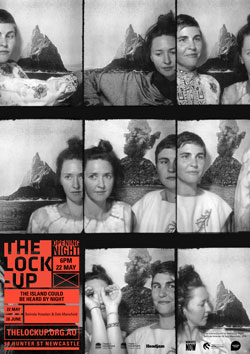Deb Mansfield exhibition at The Lock-Up
On Friday 22 May, Deb Mansfield in collaboration with Belinda Howden will launch The Island Could Be Heard by Night at The Lock-Up, Newcastle.
The Island Could be Heard by Night, by Deb Mansifeld and Belinda Howden, focuses on island histories and sea-faring myths, and investigates the island narrative of Nobby's Head (Whibayganba), Newcastle NSW.
When
Exhibition 22 May to 28 June 2015
Where
The Lock-Up
90 Hunter Street
Newcastle NSW
About
 Once a stand-alone island at the mouth of the Hunter River, the form and
conception of Nobby's Head has changed significantly since European
colonisation. The visiting tall ships of the early colony viewed the
island as an obstruction. The threat of shipwreck at the mouth of what
could be a very productive port resulted in significant tunnelling into
the base of the island, an intention to eradicate the site by
explosives. In the expansive years of settlement the island was viewed
as an asset. The rich seam of coal running through its body saw the
island severely quarried, reduced and flattened by a third of its
original height. And in 1818, in an effort to improve the islands
productivity, the construction of a convict-built pier was ordered.
After thirty-eight years of hard labour the pier was complete and has
since connected island to mainland.
Once a stand-alone island at the mouth of the Hunter River, the form and
conception of Nobby's Head has changed significantly since European
colonisation. The visiting tall ships of the early colony viewed the
island as an obstruction. The threat of shipwreck at the mouth of what
could be a very productive port resulted in significant tunnelling into
the base of the island, an intention to eradicate the site by
explosives. In the expansive years of settlement the island was viewed
as an asset. The rich seam of coal running through its body saw the
island severely quarried, reduced and flattened by a third of its
original height. And in 1818, in an effort to improve the islands
productivity, the construction of a convict-built pier was ordered.
After thirty-eight years of hard labour the pier was complete and has
since connected island to mainland.
The transformations imposed upon Nobby's Head are radical. At the hand
of human intervention the island has been violently rejected, slowly
degraded and permanently folded into the form of the dominant landscape.
These shifts in shape and function reflect the potency of island
spaces, their ability to capture prevailing cultural imagination. The
island can operate as an object of desire and otherness, death and
salvation, homogeneity and uniqueness. They can be viewed as property,
an outlier, a body or model for the self. Or in other words, an island
is the ideal space for ideas.
Nobby's Head not only tells of a complex historical narrative, it is a
compelling example of an island lost. Its dual identity – open and
closed, once bound and now connected – caught the attention of Mansfield
and Howden. With arts practices that share a common fascination for the
cultural and figurative potential of island spaces, they explore the
landscape as a mythologised site. Across the two exhibition spaces,
gallery and publication, they unpack and contribute to the layers of
fictionalised landscape that makes up Nobby's Head today.
Contact
- Deb.Mansfield@newcastle.edu.au
- Phone: 02 4921 6679
Related news
- University proposes new student accommodation at Callaghan Campus
- Polymer science PhD student wins prestigious ATSE award
- University proposes new student accommodation at Callaghan Campus
- Healthy recognition: Dietitian earns prestigious Australian science honour
- Nine Newcastle teams secure $5.4m in ARC Discovery grants to unearth new knowledge
The University of Newcastle acknowledges the traditional custodians of the lands within our footprint areas: Awabakal, Darkinjung, Biripai, Worimi, Wonnarua, and Eora Nations. We also pay respect to the wisdom of our Elders past and present.